Life in the deep sea: Biodiversity of ocean depths unlike any other place on Earth
The biodiversity of creatures living in the deep sea is unlike that seen in any other place on Earth, researchers have discovered. Analysis of brittle and basket stars living at different depths has shown major differences in the drivers of diversity, potentially providing a "global baseline for conservation efforts" for these deep dwelling creatures.
The deep ocean is the biggest and least-explored area of the planet. At depths of up to 6,500m, it is extremely energy-deficient, yet it is home to a massive variety of life. As scientists begin to get a better understanding of this vast ecosystem, it is becoming increasingly apparent how important they are to the rest of the planet.
In a paper published in the journal Nature, scientists from Australia and the UK wrote: "Deep-sea environments comprise approximately 66% of global sea-floor area, and hence more than half of the planet's surface. The sinking of biological material to the sea floor is a critical part of the global carbon cycle and climate. Yet global patterns of sea-floor diversity remain unknown, having so far been described only on local and regional scales."
Researchers examined biodiversity patterns of the deep ocean by examining the global distribution records of 165,000 brittle and basket star species (Ophiuroidea). This class (a relative of starfish) is a "dominant component of sea-floor fauna" and is found at various ocean depths, meaning their biodiversity can be compared.
The team looked at the distribution of Ophiuroidea at three depths: the continental shelf (between 20 and 200m); the upper continental slope (200 to 2,000m) and the deep-sea (2,000 to 6,500m). Findings showed the two shallower depths had similar patterns of biodiversity, with peaks seen in tropical latitudes of the Indo-west Pacific and Caribbean. Their patterns were also explained by temperature – relating to thermal energy from the sun.
However, biodiversity in the deep sea was found to be richer at higher latitudes and was correlated with chemical energy export i.e. the amount of food available. They also found biodiversity was greatest in areas close to points where continents meet the ocean floor. The team says this suggests diversity in the deep ocean relies on chemical energy, unlike the rest of the ocean that relies on thermal energy.
Life in the deep is coming under increasing pressures. The researchers say their findings can be used to put conservation measures in place to protect the species living there: "Our results provide a much-needed empirical and spatial baseline for global conservation planning in the deep ocean, which is urgently motivated by the accelerating pressures from deep-sea fishing, mining and other cumulative impacts on this vulnerable region," they wrote.




© Copyright IBTimes 2025. All rights reserved.





















